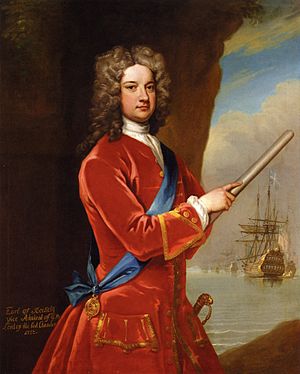James Berkeley, 3rd Earl of Berkeley facts for kids
Quick facts for kids
Admiral The Right Honourable
The Earl of Berkeley
|
|
|---|---|

The 3rd Earl of Berkeley by Godfrey Kneller
|
|
| First Lord of the Admiralty | |
| In office 1717–1727 |
|
| Monarch | George I |
| Preceded by | The Earl of Orford |
| Succeeded by | The Viscount Torrington |
| Personal details | |
| Born | c. 1679 |
| Died | 17 August 1736 |
| Nationality | British |
| Residence | Great Britain |
| Awards | Knight of the Garter |
| Military service | |
| Allegiance | |
| Branch/service | |
| Years of service | 1699 - 1727 |
| Rank | Vice-Admiral |
| Commands | HMS Boyne HMS St George |
| Battles/wars | War of the Spanish Succession |
James Berkeley, 3rd Earl of Berkeley (around 1679 – 17 August 1736) was an important English Royal Navy officer. He was also a peer, which means he held a special noble title. From 1717 to 1727, he held a very high position called First Lord of the Admiralty. This role meant he was in charge of the entire British Navy.
James was the son of Charles Berkeley, 2nd Earl of Berkeley. Before he became the Earl of Berkeley in 1710, people knew him by the special title of Viscount Dursley.
Contents
Viscount Dursley began his career in the Royal Navy on 10 March 1699, when he became a lieutenant. He quickly moved up the ranks and was promoted to captain on 2 April 1701.
He also served as a Member of Parliament (MP) for Gloucester from 1701 to 1702. This meant he helped make laws for the country.
Battle of Málaga
In 1704, Dursley took part in the Battle of Málaga. He was in command of a ship called HMS Boyne. This battle was a major naval fight during the War of the Spanish Succession.
In 1705, he was called to join Parliament early as Baron Berkeley. This was a special way to bring him into the House of Lords. He continued to advance in the Navy at the same time.
Rising Through the Ranks
In 1706, Dursley commanded another ship, HMS St George. He had a very close call during the Scilly naval disaster in 1707. Many ships were lost, including HMS Association, commanded by Sir Cloudesley Shovell.
A Narrow Escape
The St George almost ran aground on the same rocks as the Association. Luckily, a big wave lifted his ship off the ledge, saving it. There's a famous story that Dursley had given Sir Cloudesley Shovell a valuable emerald ring. This ring is part of the legends told about the disaster.
After Sir Cloudesley Shovell's death, many naval officers were promoted. Dursley, who was younger than some others, was promoted to Vice Admiral of the Blue in January 1708. This promotion was partly due to his family's political connections. Later in 1708, he became Vice Admiral of the White. In April 1709, he recaptured HMS Bristol from the French, but the ship sank soon after. By December 1709, he was promoted again to Vice Admiral of the Red.
Becoming Earl and Political Roles
When his father passed away on 24 September 1710, Dursley inherited his titles and became the 3rd Earl of Berkeley. This meant he became a very important noble.
That same year, he took on many other important roles:
- High Steward of Gloucester
- Warden of the Forest of Dean
- Constable of St. Briavel's Castle
- Lord Lieutenant of Gloucestershire (a royal representative)
- Custos Rotulorum of Surrey (in charge of county records)
He held some of these roles until 1712, and then again from 1714 until his death. In 1714, he was also made a Lord of the Bedchamber, a personal attendant to the King.
Family Life
On 13 February 1711, James Berkeley married Lady Louisa Lennox. She was the daughter of Charles Lennox, 1st Duke of Richmond. They had two children together:
- Lt. Col. Augustus Berkeley, 4th Earl of Berkeley (born 18 February 1715)
- Lady Elizabeth Berkeley (born 15 January 1716)
Sadly, his wife, Lady Louisa, passed away on 15 January 1716, shortly after giving birth to their daughter.
First Lord of the Admiralty
On 16 May 1717, James Berkeley was appointed First Lord of the Admiralty. This was a very powerful position, making him the head of the Royal Navy. He also became Vice-Admiral of Great Britain and a member of the Privy Council, which advised the King.
On 31 March 1718, he received a very high honor: he was made a Knight of the Garter. He led the Admiralty Board for over ten years. However, he was removed from his position as First Lord of the Admiralty on 2 August 1727. This happened because he disagreed with Sir Robert Walpole, who was a very powerful politician at the time. He also left his role as Lord of the Bedchamber.
In 1719, he was one of the main supporters of the Royal Academy of Music (1719). This organization helped produce baroque opera shows.
Later Life and Legacy
James Berkeley passed away on 17 August 1736 at the Château d'Aubigny in France. He was buried on 31 October 1736 in Berkeley, Gloucestershire. His son, Augustus Berkeley, 4th Earl of Berkeley, inherited his titles. His daughter, Elizabeth, married Anthony Henley in 1728.
Lord Hervey, a writer of the time, described him as a "man of great family and great quality." He said Berkeley was "rough, proud, hard, and obstinate," but also "honourable, gallant, observant of his word." This means he was a strong and honest person, even if he could be difficult.
Images for kids


